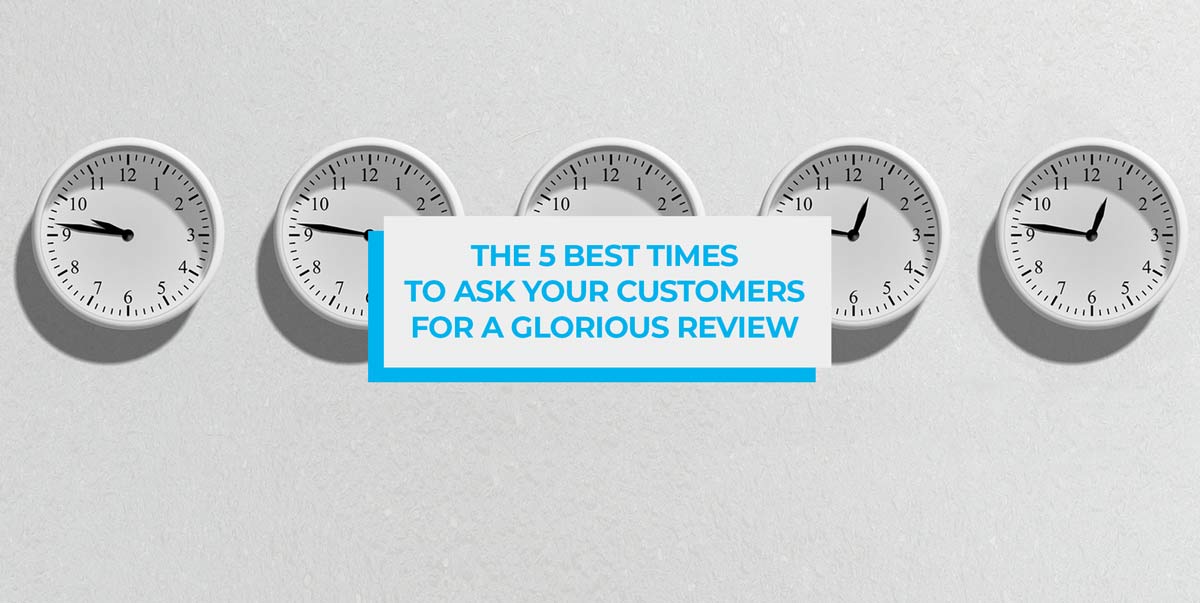Almost all of us rely on reviews before purchasing a product. Even if the product is massively-popular, like a Tesla, we ask our friends, relatives, and colleagues before we purchase something. And most importantly, we read a lot of online reviews before clicking on “Buy Now”.
Given this, it only makes sense to get as many customer reviews as possible for your online shop. In fact, if you’re not actively getting (and featuring) reviews on your shop, you’re hurting sales.
Getting a decent customer review is hard enough. People generally don’t leave reviews. If you ask them for a review but slip up even slightly in the process, you’ll come across as pushy.
But if you think hard enough about getting customer reviews, one simple variable turns out to be the most important factor in deciding how successful you will be in getting great customer reviews.
Any guesses?
Timing.
When you ask for a customer review plays a huge role in how successful you are in getting those juicy, conversion-rate-boosting reviews.
Think about it for a second. You can’t ask for a review from one of your customers randomly. (oh well, technically, you can, but it won’t work well for your brand)
The best time to ask for a review is when the customer is happy, content, impressed, surprised, or delighted enough to type those few good words about you (or your shop/brand). This is the core of timing so let me repeat it. The best time to ask for a review is when your customer is delighted. Happy. Upbeat.
And here are the 5 best times when your customer will be happy, upbeat or delighted enough that you can ask for a review!
1. When they talk to you about a positive experience

Typically, very few customers talk to you when they have had a positive experience from your shop (as opposed to almost all of them leaving reviews if they had a bad experience).
So, when a customer reaches out to you with some positive comment, it’s a goldmine. That customer has shown “initiative”.
When a customer emails you (or contacts you via a form on your shop) with a positive message about their shopping experience, don’t just leave a “thank you” reply.
Ask them — politely — if they’d be able to leave an honest review.
The chances of them doing so is much more than sending a mass-email to your customers.
2. Right when they open your product (a nice handwritten note)

Think about the last time you got something you ordered online. Think about the excitement of opening the package. Think about the delight in finally having the product in your hands.
Even if you didn’t notice it consciously, we are excited to get things we ordered and finally hold them in our hands. We’re delighted about this whole experience.
And that’s a great, proven time to slip in a review request.
In fact, it’s quite common to find a review-form or a review request in the package.
But that’s “oh-so-boring” that people miss (or ignore).
So, while you decide to send in a review request along with the package, make sure you do it with some great creativity. A handwritten note, a beautifully-designed card… anything that grabs your customer’s attention will help you increase the chance of getting an honest review from them.

3. When they hit a milestone (# of products, value of a sale)

Most savvy ecom entrepreneurs use customer milestones to sell more. But you could also use them to get glorious reviews instead of just trying to sell more!
Milestones can be super arbitrary (and still sound normal). Like, when a customer’s total purchase from your shop exceeds $250. Or when a customer buys from you 5 times. Or when a customer comes back to your shop (and buys) within a short time of their first purchase.
Milestones like these indicate that the customer likes purchasing from your shop. (The corollary is that you have to pick such milestones).
And what better time to ask for a review than when the customer has proved his/her liking for your shop?
Pick good milestones, and send out your review requests when customers hit those milestones.
4. When they reach out to you on social media

Even way back in 2013, most people talked to the brands they buy from on social media.
It’s 2017 and Facebook, Twitter, Instagram, etc. are turning out to be great for customers to get their issues addressed quickly.
When you handle customer queries on social media, you can use that opportunity to pitch for a review. Of course, not every customer interaction on social media can be turned into a “get customer review” campaign (and that’s just bad for your business).
But pay just the right amount of attention to how good the customer feels after the interaction and you will get a clear idea of which interaction can be pushed to get a review from the customer.
Aside: A simple but effective way to tap your social media fans for some great reviews even without customers initiating conversation, is to catch them on their social news feed.
Post on social media at regular intervals (say, once a month) asking your fans to leave you some feedback. That’s beneficial both ways — you’ll get real customer feedback that will help your brand and you’ll also have good, positive reviews which you can then use on your shop!
Sign-up to our newsletter and receive a free eBook with hidden Email Marketing Tips
5. Seasons and special days

Most online sellers turn every day/season of celebration into a period of massive, discount-induced aggressive marketing. That’s okay but there’s a lot of room to think a little outside the box.
By now, we are all so much used to seeing all these seasonal sales that we are close to “banner-blindness” on them. Open inbox, see discount subject line, mark, delete.
Doing something slightly different can get people to pay attention to your email. One of those things is asking for a review.
It may sound odd (or awkward). No one usually sends an email that goes, “Hey can you send us a review” on Thanksgiving but it’s not entire out of place. People know businesses thrive on the reviews they get. Being honest about the request can get you those precious, business-boosting reviews.
Some things to be wary about:
FTC guidelines: Be careful of this — FTC prohibits you from offering any incentive in return for a review. That’s against their ethical guidelines and can get you into trouble. So, the simple rule of thumb here is: never incentivize reviews.
Don’t “lead”: Don’t ever ask for a “good” review or a “positive” one. Just ask for an honest review.
Final words
It’s time to wrap up your reading and start putting your ideas into action. Find out which of these five times fits your brand best to ask for reviews.
And once you get them, don’t stop! Publish them on social media, on your shop, on product listings and other places where conversions happen!
Also, I want to know your thoughts on how you get your customer reviews. And when do you ask for them?
Written By Chandru Rao
Chandru works at Around.io to help online sellers and small businesses automate, optimize and make the best out of social media marketing.





